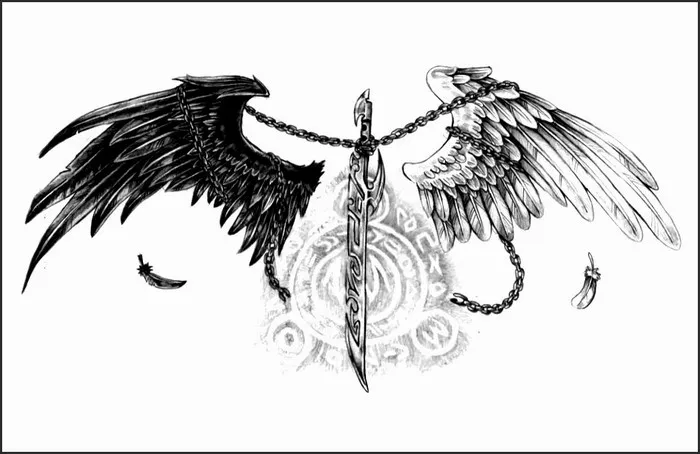In the realm of body art, tattoos serve as a visual language, often conveying personal beliefs, cultural affiliations, or symbolic representations. Among the myriad of tattoo designs, the devil wing tattoo stands out as a captivating yet enigmatic motif, sparking curiosity and prompting questions about its significance. Delving into the depths of symbolism, mythology, and personal interpretation, this article aims to unravel the intricate meaning behind the devil wing tattoo.
Origins of the Devil Wing Tattoo
To comprehend the significance of the devil wing tattoo, it is essential to explore its origins and cultural associations. The motif finds its roots in various mythologies and belief systems, where the concept of the devil or demonic entities is prevalent.
One of the earliest depictions of winged demonic beings can be traced back to ancient Mesopotamian mythology, where creatures such as the Lamassu were depicted with the body of a bull or lion and the wings of an eagle. These beings were often considered protective spirits, guarding palaces and cities from malevolent forces.
In Christian theology, the devil, also known as Lucifer or Satan, is commonly depicted as a fallen angel who rebelled against God. The imagery of angelic wings turned dark and twisted symbolizes this fall from grace and the embrace of evil or temptation.
Symbolism of the Devil Wing Tattoo
The devil wing tattoo encompasses a multitude of symbolic interpretations, ranging from rebellion and defiance to personal empowerment and self-expression. Understanding the diverse layers of symbolism embedded within this motif is crucial to deciphering its meaning.
1. Rebellion and Defiance
At its core, the devil wing tattoo often serves as a symbol of rebellion against societal norms or religious dogma. By embracing imagery associated with the devil or demonic entities, individuals may express their rejection of mainstream beliefs and their desire to carve out their own path in life. This rebellious spirit can manifest in various forms, from challenging authority to rejecting conventional morality.
2. Embrace of Darkness
In some interpretations, the devil wing tattoo represents an embrace of darkness or the shadow aspects of the self. Rather than shying away from aspects deemed taboo or undesirable by society, individuals may choose to confront and integrate these facets into their identity. This acknowledgment of the dark side can be a powerful act of self-acceptance and empowerment.
3. Symbol of Temptation
The devil has long been associated with temptation and seduction, luring individuals into moral or spiritual peril. The devil wing tattoo may serve as a reminder of the allure of forbidden desires and the need for vigilance against succumbing to temptation. It can also symbolize a fascination with the darker aspects of human nature and the complexity of moral ambiguity.
4. Personal Empowerment
Contrary to its negative connotations, the devil wing tattoo can also serve as a symbol of personal empowerment and strength. By embracing imagery traditionally associated with evil or danger, individuals reclaim these symbols as a testament to their resilience and inner fortitude. This reinterpretation can be particularly empowering for those who have faced adversity or struggled to overcome challenges in their lives.
Interpretations Across Cultures
While the devil wing tattoo is often associated with Western cultural contexts and Judeo-Christian symbolism, its meaning can vary significantly across different cultures and belief systems.
In Japanese culture, for example, the imagery of demons or oni is prevalent in traditional folklore and art. These demonic beings are often depicted with monstrous features and exaggerated expressions, serving as symbols of chaos and disruption. A devil wing tattoo inspired by Japanese folklore may carry distinct connotations related to the struggle against inner demons or the pursuit of personal transformation.
Similarly, in Norse mythology, creatures such as the Valkyries are depicted with wings, symbolizing their role as choosers of the slain and guides to the afterlife. A devil wing tattoo inspired by Norse mythology may represent a connection to themes of destiny, honor, and the inevitability of death.
Personal Interpretation and Expression
Ultimately, the meaning of a devil wing tattoo is deeply personal and can vary significantly from one individual to another. While some may embrace the rebellious and defiant symbolism associated with the motif, others may resonate more with themes of personal empowerment or spiritual exploration.
For many, the devil wing tattoo serves as a canvas for self-expression and storytelling, allowing them to communicate their values, beliefs, and life experiences through visual imagery. Whether viewed as a symbol of rebellion, empowerment, or personal transformation, the devil wing tattoo continues to captivate and intrigue both wearers and observers alike.
In conclusion, the devil wing tattoo encompasses a rich tapestry of symbolism and interpretation, drawing upon diverse mythological, cultural, and personal influences. From its origins in ancient mythology to its modern-day manifestations in body art, this motif serves as a powerful emblem of individuality, defiance, and self-expression. As with any form of art, the true meaning of the devil wing tattoo lies in the eye of the beholder, inviting us to explore the depths of our own beliefs, desires, and aspirations.

